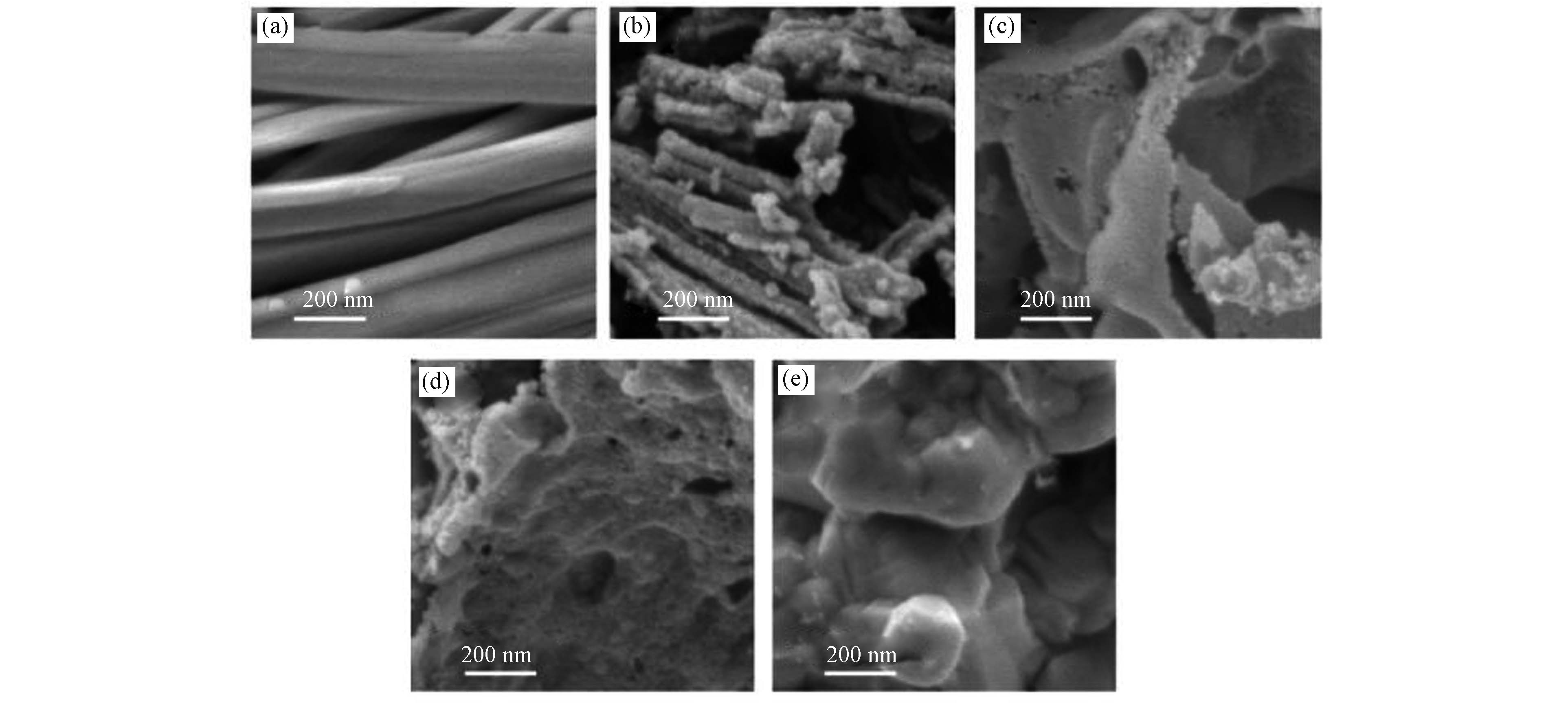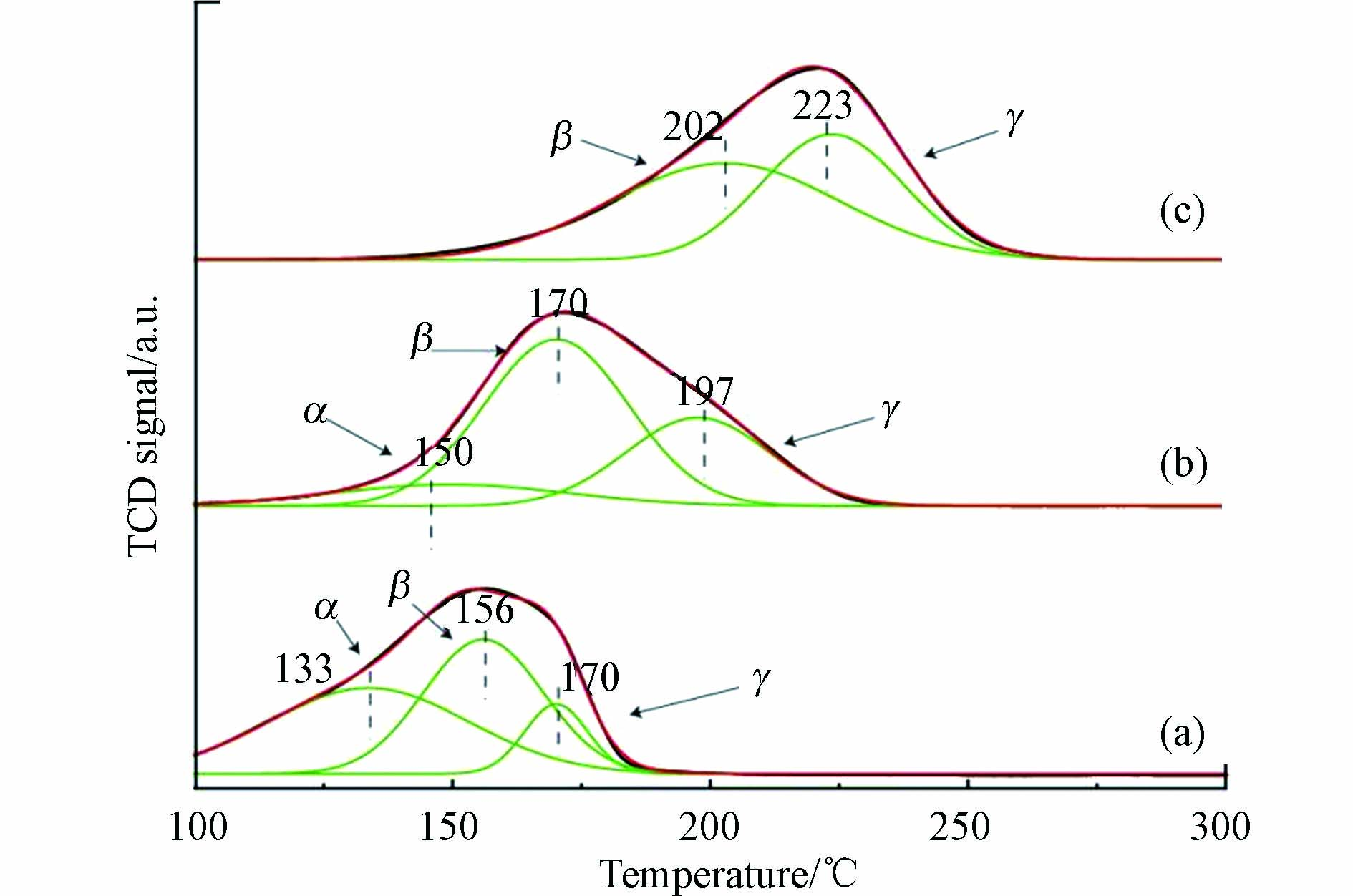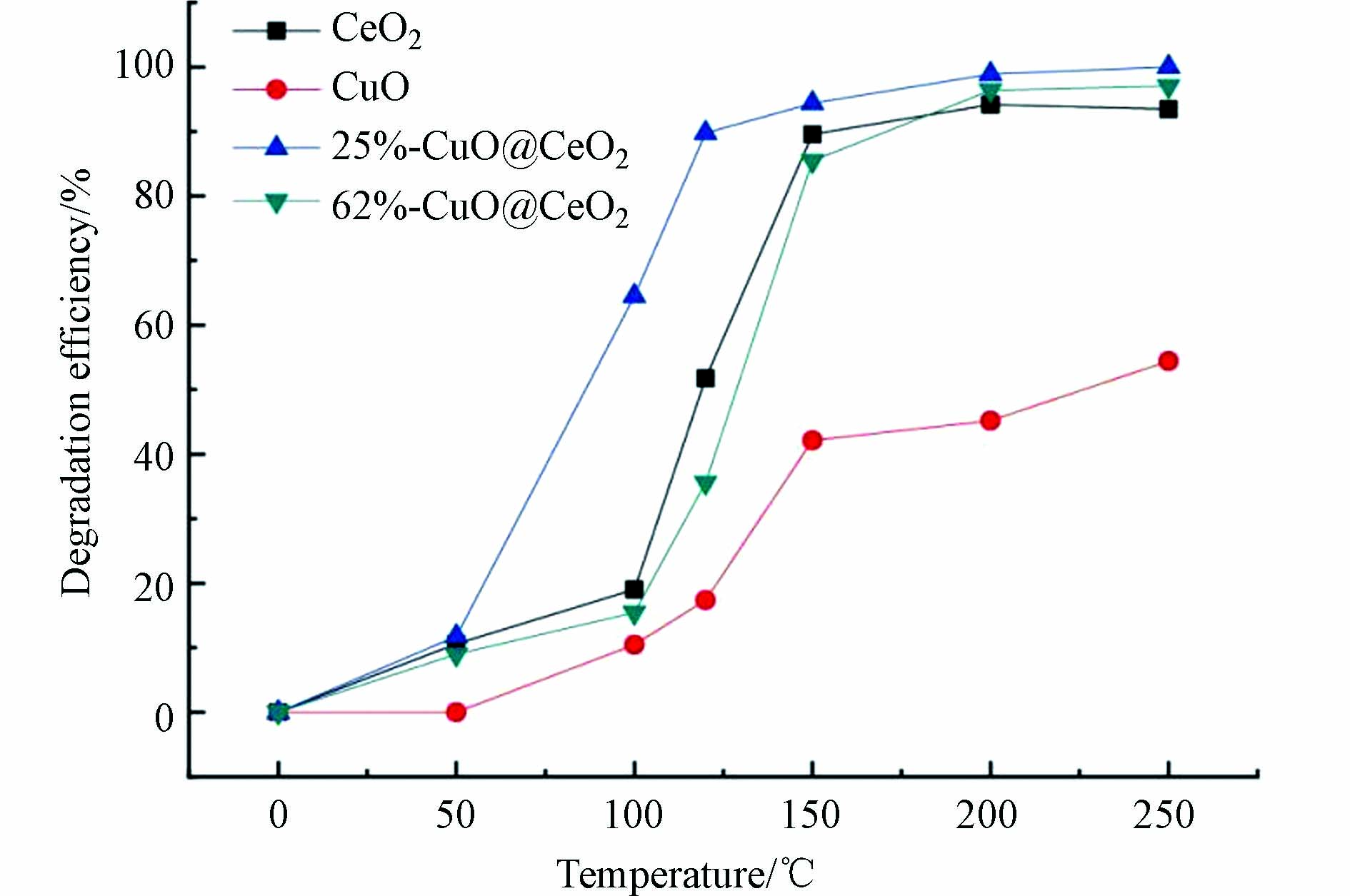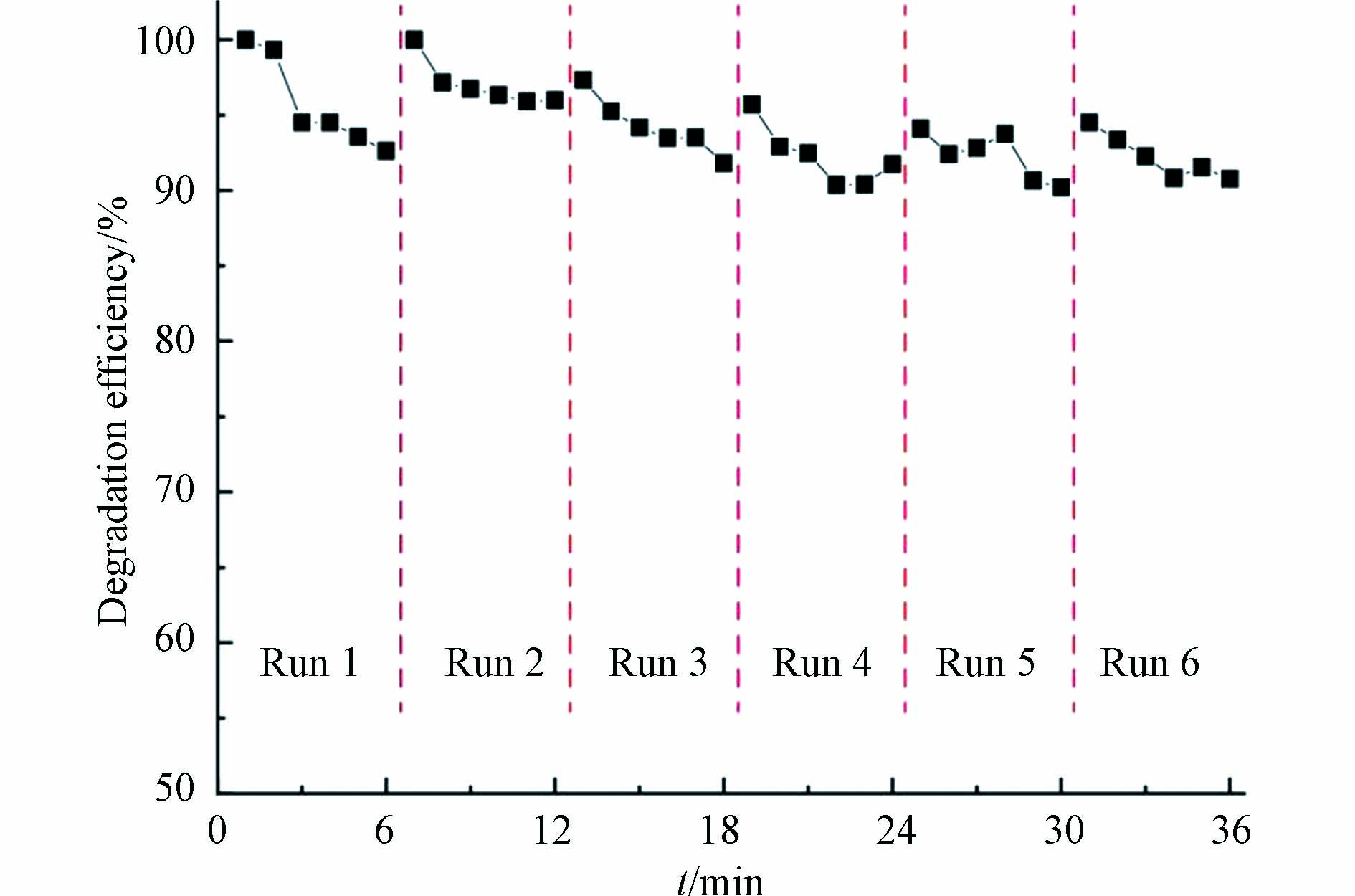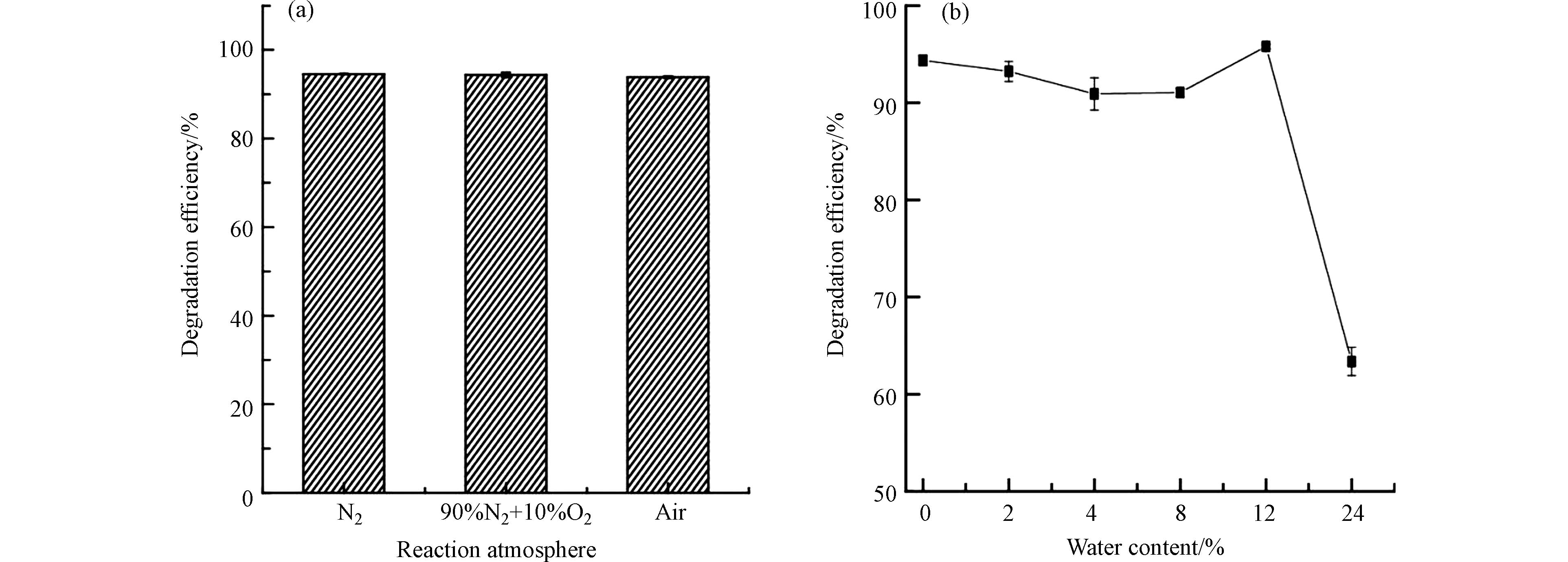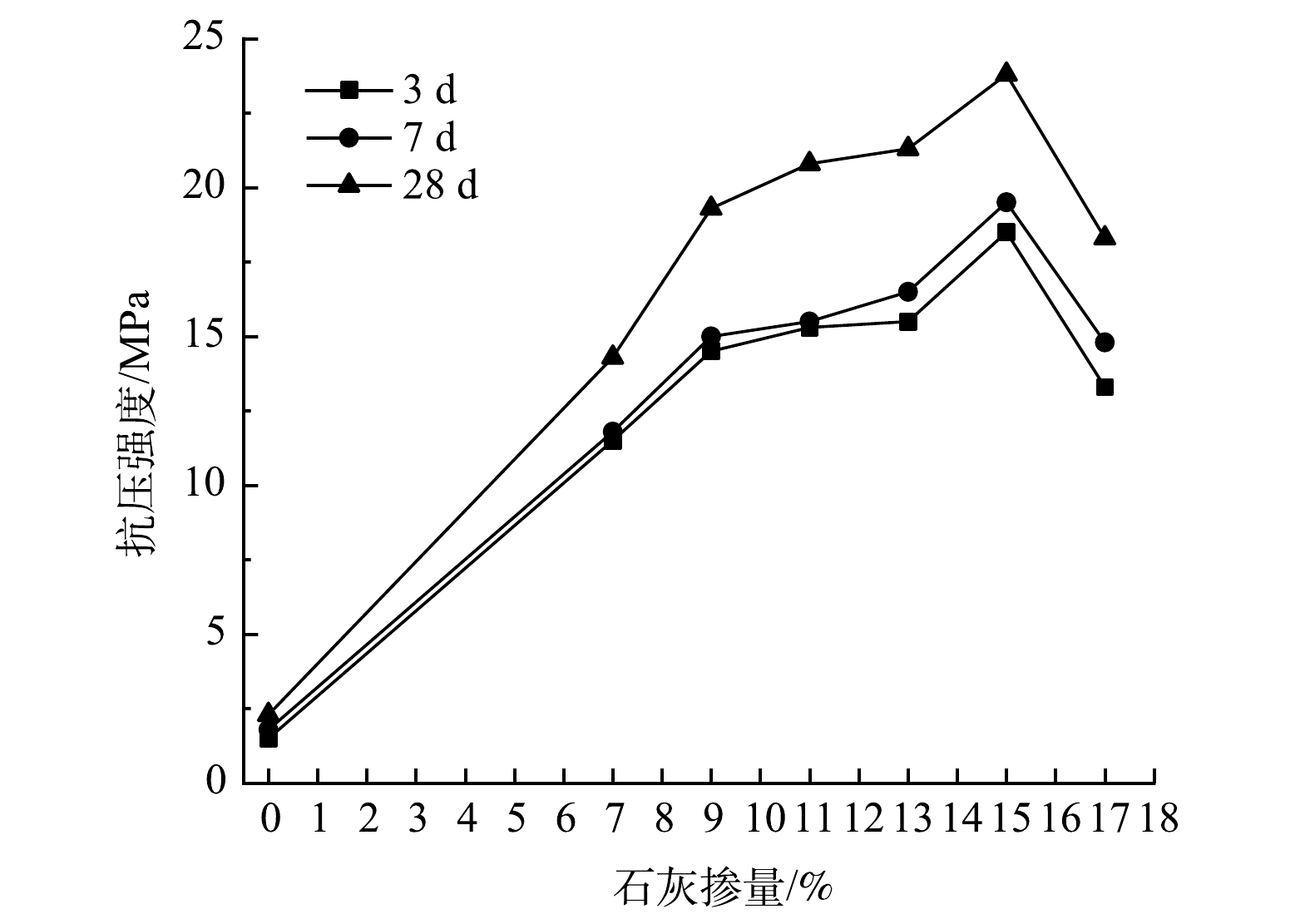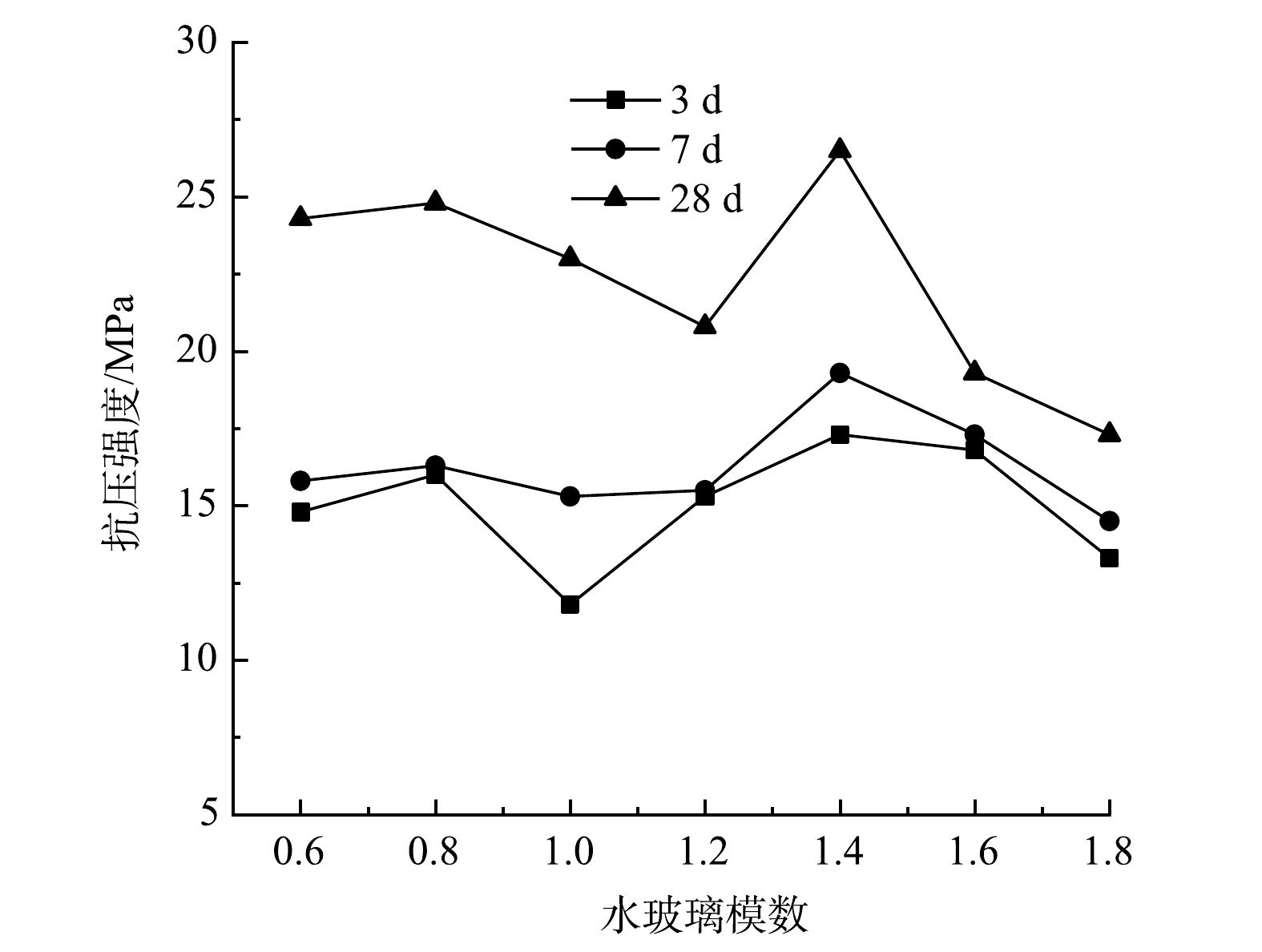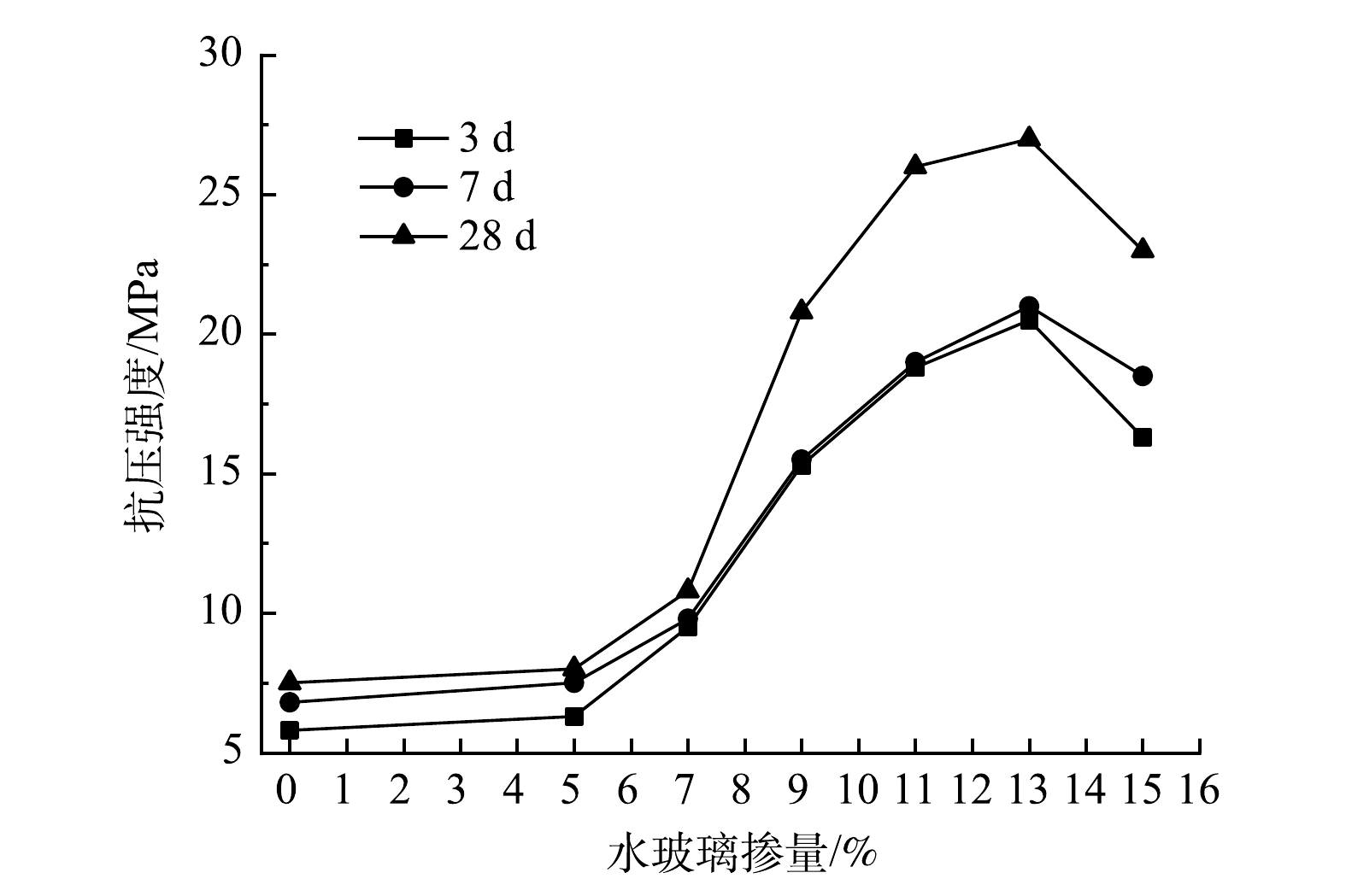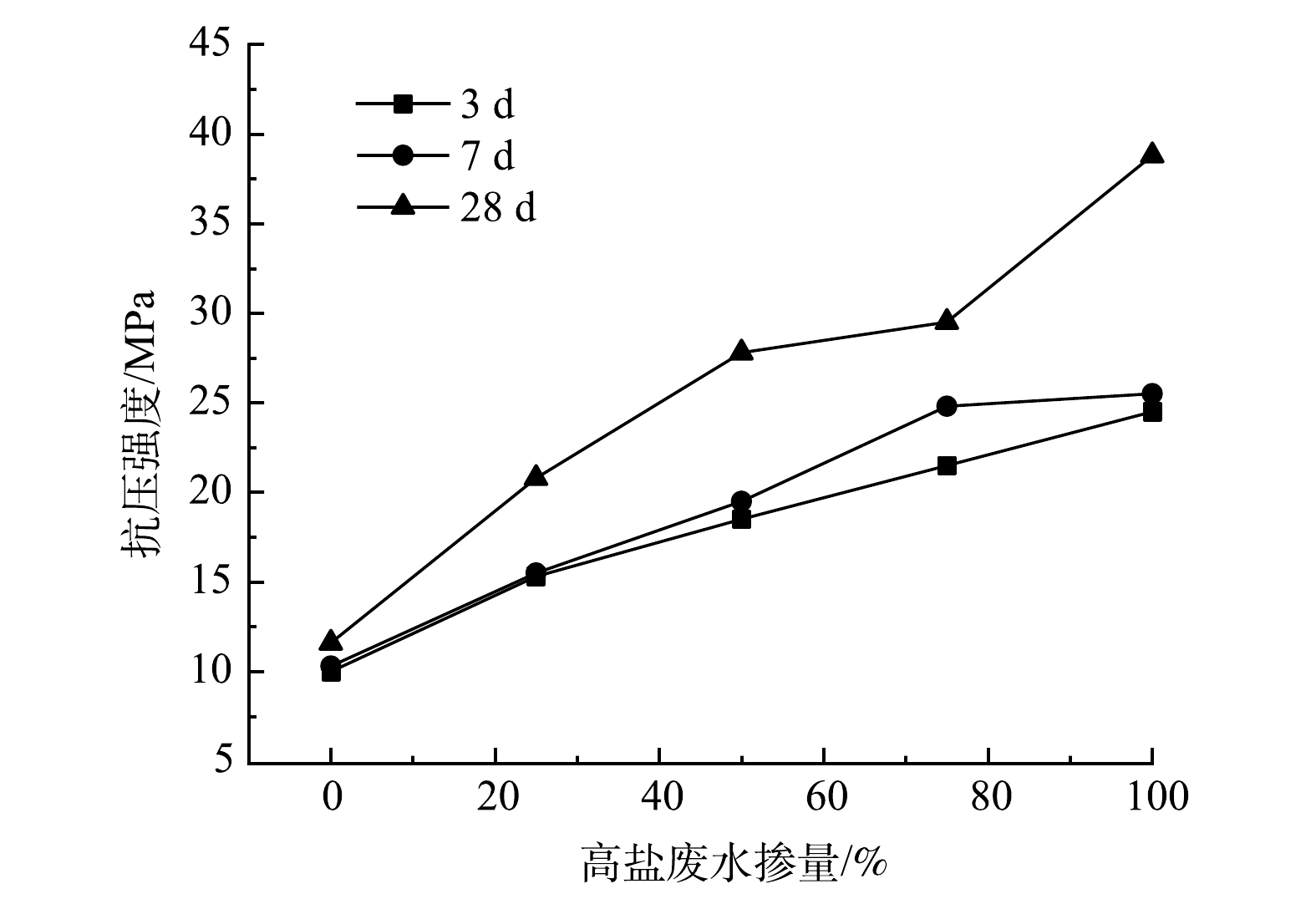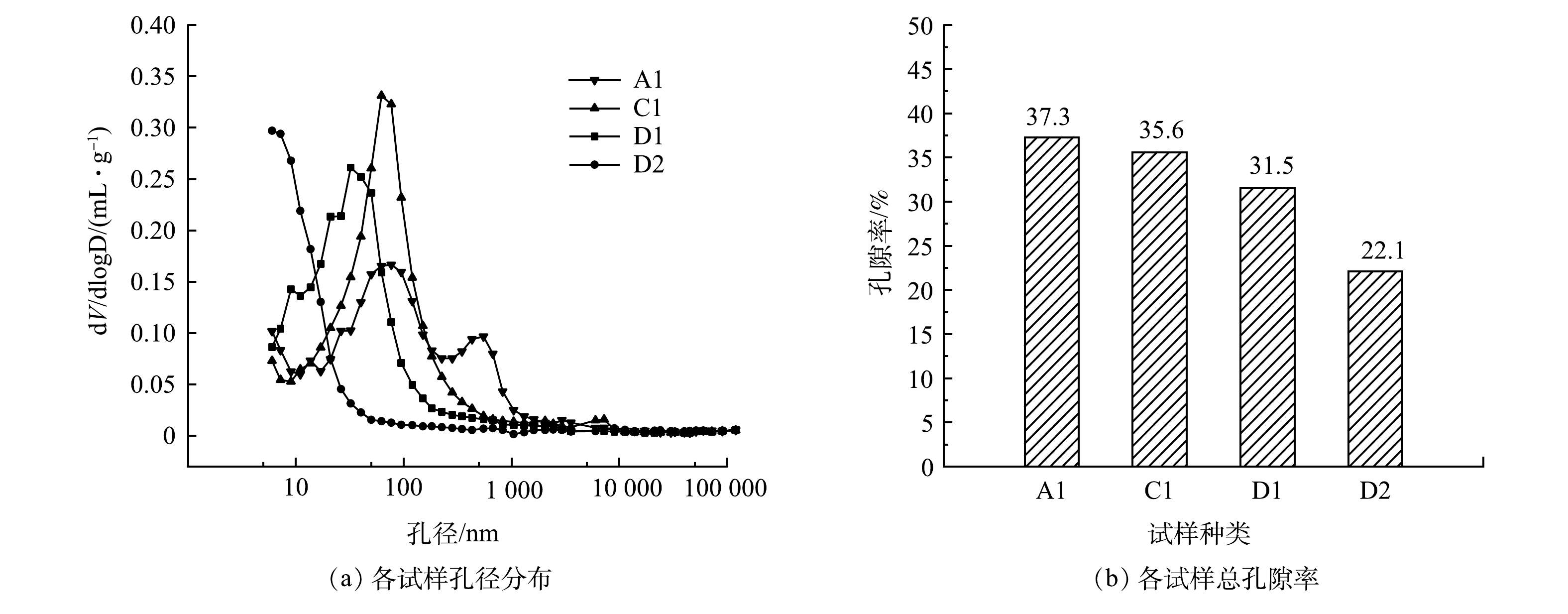-
目前,我国的能源结构仍然是以煤炭为主[1]。煤炭燃烧会产生大量温室气体破坏环境。煤炭的清洁高效利用是未来发展的必然趋势。煤气化是煤炭清洁高效利用的核心技术之一[2],也是现代煤化工产业的基础。但煤气化过程中会产生大量的废渣和高盐废水。目前,气化渣的处理方式主要为堆存和填埋,尚未实现大规模综合利用,造成了严重的环境污染和土地资源浪费[2]。高盐废水则主要是通过闪蒸去除水分后,富集盐分再统一固化填埋处置。这种处理方式能耗高、成本大,还容易产生二次污染。因此,实现煤气化渣和高盐废水的高效安全处置与资源化利用是煤化工产业可持续发展必须要解决的关键问题。
目前,较多学者对煤气化渣进行了深入研究。赵永彬等[3]研究了宁煤集团3种煤气化炉粗渣的化学组成及矿物相构成,发现其化学组成主要包括SiO2、Al2O3、CaO、Fe2O3。其中,矿物组成主要以非晶态玻璃体和晶相矿物为主;非晶态玻璃体的含量达到67%以上,晶相则以石英、莫来石、方铁矿和方解石为主。煤气化渣分为细渣和粗渣。粗渣具有较高的火山灰性,可作为一种辅助性胶凝材料应用于水泥混凝土中[4-7]。冀文明等[8]以矿渣微粉为胶凝材料的主要成分,将CaSO4、水玻璃、NaOH、CaCl2制成复合激发剂,得到新型复合激发矿渣胶凝材料的最优配比,复合激发剂对矿渣的火山灰性具有一定的激发效果。吴波波等[9]以低品位粉煤灰混凝土为研究对象,加入石灰、硅酸盐水泥、水玻璃激发粉煤灰,发现石灰与激发剂共同作用,可加速粉煤灰地质聚合反应,促使N-A-S-H和C-A-S-H、C-S-H等凝胶生成,从而提高混凝土强度。此外,煤化工产生的高盐废水由有机物和无机盐2大类组成,有机物种类多,同时还含有氰化物、芳香族及杂环化合物等有毒物质且处理困难[10]。高盐废水COD较高,一般在500~5 000 mg·L−1;其次,高盐废水中盐分质量浓度高,通常在3 000~15 000 mg·L−1,主要含有K+、Na+、Mg2+、Ca2+等阳离子,CO32−、NO3−、Cl−、SO42−等阴离子。其中,Na+、Cl−和SO42−占到无机离子质量分数的90%以上[11]。KABOOSI等[12]曾尝试将工业废水作为混凝土的拌合水,以节约水资源。目前,利用工业废弃物制备胶凝材料是研究的热点,但多利用粉煤灰及矿渣制备胶凝材料。这是由于煤气化渣活性低等原因,故导致针对煤气化渣直接制备胶凝材料的研究较少。
本研究以煤气化渣为原料,利用高盐废水、水玻璃及石灰复合激发剂,制备化学激发胶凝材料;研究石灰掺量、水玻璃模数与掺量及高盐废水掺量,对煤气化渣胶凝材料力学性能的影响;探讨胶凝材料水化产物的作用机制,并讨论其对环境的安全性。拟为煤化工废渣、废水的综合利用探索一条新途径。
-
所用煤气化渣为宁煤集团提供的粗渣,将其烘干后,用球磨机粉磨,比表面积为413 m2·kg−1、平均粒径为21.58 µm,其化学组成见表1。所用高盐废水也来自宁煤集团,含有高浓度的氯盐、硫酸盐、有机物,重金属质量浓度低,为淡黄色液体,其水质见表2。高盐废水中重金属的质量浓度见表3。水玻璃(Na2SiO3)利用NaOH调整其到所需模数,所用氢氧化钠(NaOH)为分析纯,生石灰(CaO)纯度大于95%。
-
确定基准配合比为:煤气化渣100%、水玻璃掺量9%、水玻璃模数1.2、石灰掺量11%、高盐废水掺量25%。在此基础上,改变石灰掺量分别为0、7%、9%、11%、13%、15%、17%,编号为A1~A7;水玻璃模数分别为0.6、0.8、1.0、1.2、1.4、1.6、1.8,编号为B1~B7;水玻璃掺量分别为0、5%、7%、9%、11%、13%、15%,编号为C1~C7;高盐废水掺量分别为0、25%、50%、75%、100%,编号为D1~D5。按配合比称取相应的原料混合,成型尺寸为20×20×20 mm的6联试块,以研究不同因素对试样性能的影响。试块在80 ℃蒸汽养护条件下养护24 h后拆模,然后置于温度为(20±3) ℃、湿度为90%以上的养护箱中,养护3、7、28 d后进行抗压强度等测试。
-
根据《建筑砂浆基本性能试验方法标准》(JGJ/T70-2009)[13],在3、7、28 d时测量立方体样品的抗压强度,每个龄期压碎3个样品,并取平均值为抗压强度。通过X射线衍射仪(D-MAX/2500PC型,日本理学公司)对养护28 d试样的物相组成进行分析。采用扫描电子显微镜(Quanta 200,美国FEI公司)对养护28 d试样的微观形貌进行分析。采用MIP(Auto pore IV 9500,美国麦克公司)测定试样的孔分布和总孔隙率。重金属浸出试验按照国家标准《固体废弃物浸出毒性浸出方法水平振荡法》(HJ 557-2010)[14]进行,采用ICP-AES(OPTIMA,美国珀金埃尔默公司)测定滤液中重金属的质量浓度。
-
1)石灰掺量对胶凝材料强度的影响。石灰掺量对试样抗压强度的影响见图1。由图1可以看出,随石灰掺量增加,试样抗压强度呈先增大后减小的趋势。在石灰掺量为15%时,试样28 d抗压强度达到23.8 MPa,比不加石灰的A1组,抗压强度提高了930%。气化渣中CaO较少,Ca2+还不足以满足其需求,只加入水玻璃仅能提高气化渣中活性硅铝的溶解,而无法形成较多的水化产物,因此强度较低。加入石灰后,为水化体系补充了Ca2+,在水玻璃-石灰-高盐废水的复合激发下,使气化渣在钠-钙-硫-氯共同作用下,形成的强碱环境能使气化渣活性物质溶出,加速活化,又提供了形成胶凝材料必要的条件Ca2+。通过共同激发所得的高活性小分子SiO2和Al2O3,与Ca( OH)2、SO42−及Cl−,生成水化硅酸钙、钙矾石及水化氯铝酸钙等水化产物,进而提高胶凝材料强度。当石灰掺量较低时,其水化生成的Ca(OH)2,虽然对气化渣颗粒内部的Al-O键和Si-O键造成一定破坏,生成活性Al2O3和SiO2,反应生成少量类沸石水化产物[15]。但是,产生的Ca(OH)2较少,且大部分气化渣还处于未活化的状态,所以石灰掺量较少时,试样强度较低。随石灰掺量提高,Ca(OH)2生成量增加,提高了OH−的浓度,使得较多气化渣颗粒释放活性成分,因此试样强度提高。直至石灰掺量在15%时,强度达到最大值。随着石灰掺量的增加,生成了过量的Ca(OH)2,然而Ca(OH)2具有膨胀性,标准养护条件下导致试件发生膨胀[16]。因此,随着石灰掺量从15%增加到17%,试样强度反而下降。
2)水玻璃模数对胶凝材料强度的影响。图2为水玻璃模数对试样抗压强度的影响,可以看出,随水玻璃模数的增加,抗压强度成先增大后减小,再增大后减小的趋势。水玻璃模数为1.4时,试样28 d抗压强度可达到26.5 MPa。随水玻璃模数的升高,Na2O质量分数降低,SiO2质量分数增加。其中,Na2O质量分数在反应过程中有2方面作用:一方面,激发剂中的Na2O的质量分数越高,pH值越大,气化渣释放出硅、铝四面单体数量越多,有利于发生生成凝胶的聚合反应,使得体系抗压强度提高;另一方面,当激发剂中碱过多时,Na+会在气化渣颗粒表面发生钝化反应,阻碍原材料的进一步溶解,导致样品强度降低[17]。激发剂中的SiO2质量分数,在反应过程中也有2方面作用:一方面,由于气化渣中Si的溶解速度较慢,激发剂掺入的SiO2能解决反应初期,灰体难以释放出足够的[SiO4]4−四面体,参与后续反应的问题,使得体系的聚合反应更充分,有效提高胶凝材料的早期强度[18];另一方面,增加激发剂中SiO2的质量分数,会导致激发剂中SiO2的聚合度大大提高,降低SiO2的反应活性,同时部分多余的SiO2,将在反应后期发生水解,生成无定型硅酸以及碱类物质,导致材料的泛碱现象[19],进而影响胶凝材料抗压强度的发展。因此,当水玻璃掺量一定时,水玻璃最佳模数值为1.4。这能够使得体系中Na2O和SiO2的质量分数对试样强度发展作用最优,制得强度最优的胶凝材料。
3)水玻璃掺量对胶凝材料强度的影响。图3为水玻璃掺量对试样抗压强度的影响,可以看出,随水玻璃掺量的增加,试样抗压强度成先增大后减小的趋势。水玻璃掺量为13%时,试样28 d抗压强度达到27 MPa,相对于不加水玻璃的C1组强度提高了260%。水玻璃的引入,促进了激发剂对煤气化渣的激发效果。仅掺石灰与高盐废水使浆体中碱度有限,大量气化渣中活性硅铝没有溶出。水玻璃可水解生成NaOH,使液相的OH−增多。同时,水玻璃还能水解生成硅胶,这些硅胶可与Ca2+反应生成C-S-H凝胶[20],进而加速气化渣与Ca(OH)2的反应,生成较多的水化产物,使得试样更加密实。不加水玻璃的C1试样,28 d强度较7 d强度增长了10.3%;加入水玻璃掺量为9%时,试样28 d强度较7 d强度增长了34.2%。水玻璃的加入,使得试样后期强度发展快。在反应初期,气化渣玻璃体中的Al-O、Si-O键发生断裂,[AlO4]5−、[SiO4]4−四面体被快速溶出形成低聚体,会在低于150 ℃的条件下发生缩聚反应,生成-Si-O-Al-O-为骨架的三维网络结构的无机高分子地质聚合物,硬化后发挥作用提高强度。随着养护龄期的增长,当试样养护到28 d时,气化渣中的氧化物原料大部分被溶解,随着解聚-缩聚反应的发生,生成了大量具有胶结作用的凝胶物质(N-A-S-H),使试样的28 d抗压强度发展较快。
4)高盐废水掺量对胶凝材料强度的影响。高盐废水掺量对试样抗压强度的影响见图4,可以看出,随高盐废水掺量的增加,试样抗压强度有不同程度的提高。当高盐废水掺量从0增加至100%时,试样28 d抗压强度,由11.6 MPa提高至38.8 MPa,提高了234%。高盐废水中含有大量SO42−、Cl−,随着高盐废水掺量的增加,SO42−浓度不断增加。一方面,SO42−在Ca2+作用下,与夹杂在颗粒表面的凝胶,及溶解于液相中的活性Al2O3,反应生成水化硫铝酸钙,即钙矾石(AFt)[21]。钙矾石具有一定的膨胀性,可以填补结构空隙,使试样密实度提高。另一方面,废水中的SO42−,能够与Na+反应生成Na2SO4,与石灰产生的Ca(OH)2反应生成NaOH,消耗其中的Ca2+,增加体系的碱度,这有助于活性SiO2、Al2O3的溶出,加速水化反应进程,从而提高试样强度[20]。其次,高盐废水中的Cl−与Ca2+,有较强扩散能力,能够穿过气化渣颗粒表面的水化层,与内部被激发后释放的活性Al2O3反应,生成水化氯铝酸钙[22];Cl−还可以与Ca(OH)2反应,生成氧氯化钙复盐,不溶于水,使得试样中固相增多,从而试样的抗压强度得到了提高。因此,随高盐废水掺量增加,试样强度不断增加,高盐废水有利于激发煤气化渣胶凝材料的活性。
-
图5为复合激发剂激发煤气化渣水化28 d的XRD图。由图5(a)可以看出,加石灰的D2中,有C-S-H和N-A-S-H的特征峰的出现。这与刘江等[23]的研究结果一致。不加石灰的A1中,C-S-H的特征峰几乎没有,因此,试样强度最低。由图5(b)可以看出,加入水玻璃的D2试样,与不加水玻璃的C1试样相比,C-S-H和N-A-S-H的特征峰增强。不加水玻璃的C1试样,有Ca(OH)2与水化氯铝酸钙(3CaO·Al2O3·CaCl2·10H2O)的特征峰出现。D2试样中无水化氯铝酸钙的特征峰出现。这可能是由于水玻璃的加入,使胶凝材料中形成很多的N-A-S-H,消耗了活性Al2O3。因此,活性Al2O3剩余量少,生成的水化氯铝酸钙的量就变少。首先,水玻璃中的Na2O为体系提供了更多的OH−,使硅铝玻璃体迅速溶解,产生大量[SiO4]4−、[AlO4]5−,使水化产物增多。其次,水玻璃中SiO2可降低水化产物的钙硅比,使水化产物的聚合度升高,体系的后期强度明显增大。此外,不加水玻璃的C1试样,生成了过量的Ca(OH)2,导致试样体积膨胀,强度降低。C1试样中没有出现氧氯化钙复盐的特征峰。这可能是,氯离子浓度低,因此其生成量少。由图5(c)可以看出,加高盐废水的D2试样,相比于不加高盐废水的D1试样,C-S-H特征峰增强。高盐废水的加入,促进了水化反应的进行,使水化产物种类增加,复合激发剂激发效果明显。邱轶兵等[21]发现,水化产物中有一定量的钙矾石,但图5(c)中没有发现钙矾石的衍射峰。这可能是由于高盐废水中硫酸根离子浓度低,故导致钙矾石的生成量较少。此外,加入高盐废水的D2试样中,有NaCl的特征峰出现,氯离子在胶凝材料中会发生迁移,这可能会对胶凝材料的耐久性产生不利影响,后续研究应考虑胶凝材料的抗冻融性等。综上,煤气化渣在复合激发剂作用下,生成较多的Ca(OH)2参与反应,促进煤气化渣中的Si-O和Al-O发生解聚-缩聚反应,形成化学激发胶凝材料。其中,生成C-S-H、N-A-S-H、水化氯铝酸钙等产物,这些产物胶结在一起,有利于提高试样结构的密实度。
-
为进一步分析复合激发剂对气化渣激发机理,分别对A1、C1、D1、D2试样的28 d水化产物进行微观分析,结果如图6所示。从图6(a)、图6(b)、图6(d)可以看出,D2试样中有较多的水化产物,堆积在被激发的气化渣颗粒表面以及颗粒间,有絮状C-S-H及网状N-A-S-H等凝胶生成。相比于A1、C1试样,D2试样中水化产物更加密集且孔隙较少,A1、C1中有较多的气化渣颗粒未被激发。D2中水玻璃水解后生成OH−,使气化渣中活性硅铝溶出。并且,水玻璃为体系提供了较多的活性SiO2,使水化产物聚合度提高,生成了较多的水化产物,使得结构更加密实。C1中未加水玻璃,气化渣中活性物质溶出较少,没有足够的SiO2参与水化反应,使得水化产物聚合度低,且生成量较少,导致试样强度较低。因此,水玻璃的加入,可明显增加水化产物种类及数量,进而提高复合激发剂对煤气化渣的激发效果。
此外,从图6(c)、图6(d)中可以看出,D2试样中有少量针棒状的钙矾石产生,水化产物之间黏结紧,结构密实度较好。相比于D1,加入了高盐废水的D2试样,废水中SO42−、Cl−,使气化渣中更多的活性物质溶出,促进水化产物的生成。并且,生成的钙矾石等产物,能够填充结构中的孔隙,使试样密实度提高。
-
图7为复合激发剂激发煤气化渣水化28 d孔结构的测试结果。由图7可以看出,加水玻璃的D2试样,孔径分布的峰值明显向孔径小的方向移动,且总孔隙率由不加水玻璃的C1试样35.6%,降低至22.1%。水玻璃中的Na2O水解后,产生的OH−能够与水及CaO反应生成Ca(OH)2,提高体系的碱度,促进了煤气化渣中活性硅铝的溶出。生成较多的C-S-H、N-A-S-H等物质,可填充于试样的孔结构,进而提高其力学性能。不加高盐废水的D1试样,孔径分布明显向孔径大的方向移动,且孔隙率相比于加高盐废水的D2有所提高。不加高盐废水的试样中没有SO42−及Cl−的作用。因此,水化产物生成量少,试样孔径大、孔隙率高。这导致试样结构不够密实,强度较低。A1试样的孔隙率最高,强度最低。
-
对不同高盐废水掺量下,制备的煤气化渣胶凝材料试样(D1、D3、D5),进行了浸出毒性检测。通过判断其是否满足《危险废物鉴别标准浸出毒性鉴别》(GB 5085.3-2007)[24]中规定的限值,来判断高盐废水加入煤气化渣胶凝材料中,对环境有无污染。各试样重金属的毒性浸出结果如表4所示。
国家标准中规定,Cr、Ni、Cu、Zn、As、Cd、Pb的浸出限值,分别不能高于5、5、100、100、5、1、5 mg·L−1。由表4可以看出,各试样中各重金属元素浸出浓度,远低于标准中的限值。利用高盐废水制备煤气化渣胶凝材料的浸出液,与原废水相比,Cr、Ni、Cu、Zn、As、Cd质量浓度均降低,而Pb质量浓度有所增加。随高盐废水掺量的增加,Ni、Cu、Zn、As、Pb浸出浓度增加,Cd浸出浓度降低,Cr的浸出浓度不变。利用复合激发剂激发煤气化渣制备的胶凝材料,对高盐废水中的重金属有一定的固化作用。因此,各元素浸出浓度得到降低。Pb浸出浓度增加可能是在激发剂作用下,煤气化渣中的活性物质释放的同时,Pb元素被释放出来,因此,其浸出浓度增加。随高盐废水掺量增加,胶凝材料中的重金属元素引入的就越多,因此,Ni、Cu、Zn、As、Pb浸出浓度增加。Cd浸出浓度降低,Cr的浸出浓度不变。这说明,在复合激发剂作用下,胶凝材料对Cd、Cr元素的固化效果好。此外,高盐废水中还存在一些铵盐,在碱性环境下会生成氨气,后续研究应考虑挥发出的氨会对大气产生的二次污染。综上所述,利用复合激发剂激发煤气化渣制备的胶凝材料,对高盐废水中的重金属元素,有一定的固化作用,且所制备的胶凝材料浸出毒性均低于国家标准中的限值。
-
1)复合激发剂中石灰掺量、水玻璃模数与掺量及高盐废水掺量,对煤气化渣胶凝材料的抗压强度,均有一定的影响。其中,当高盐废水掺量为100%时,试样的28 d抗压强度,最高可达38.8 MPa。
2)水玻璃中的Na2O为体系提供了OH−,使煤气化渣中活性物质溶出,产生大量[SiO4]4−、[AlO4]5−,使水化产物增多;水玻璃中的SiO2可降低水化产物的钙硅比,硅氧四面体链变长,提高产物的聚合度,生成较多C-S-H、N-A-S-H等水化产物,使试样结构更加密实,体系的后期强度明显增大。
3)复合激发剂对煤气化渣激发效果显著。这主要因为激发剂提供了较多的SO42−、Cl−及OH−,使气化渣活性被激发,并且引入Ca2+,促进Ca(OH)2、C-S-H、N-A-S-H、钙矾石和水化氯铝酸钙等物质的生成,使试样孔隙率降低,故本研究所制备的胶凝材料能固化高盐废水中的部分重金属。
复合激发煤气化渣基胶凝材料的制备
Preparation of composite activated coal gasification slag-based cementitious materials
-
摘要: 为提高煤化产业废渣、废水的综合利用,以煤气化渣为原料,高盐废水、水玻璃及石灰为复合激发剂制备胶凝材料。探究了复合激发剂中石灰掺量、水玻璃模数、水玻璃掺量及高盐废水掺量对胶凝材料力学性能的影响;借助XRD、SEM、MIP、ICP-AES等分析手段对激发剂作用下煤气化渣胶凝产物及其微观形貌进行表征,并讨论了胶凝材料对环境安全性的影响。结果表明,当石灰掺量为15%时,试样28 d抗压强度可达到23.8 Mpa;水玻璃模数为1.4时激发效果最好,水玻璃最佳掺量为13%;高盐废水掺量为100%时,试样28 d抗压强度为38.8 MPa。微观观察结果表明,水玻璃可促进煤气化渣硅铝玻璃体的溶解,提高水化产物聚合度,生成C-S-H、N-A-S-H使得体系的结构更加密实,后期强度增大。此外,复合激发剂在SO42-、Cl-、OH-、Ca2+的共同作用下,可显著提高气化渣活性并加速其水化反应,生成Ca(OH)2、C-S-H、钙矾石和水化氯铝酸钙等物质,使试样孔隙率降低,强度提高。并且,胶凝材料可固化高盐废水中的重金属。本研究结果可为煤气化渣制备胶凝材料提供参考。Abstract: In order to improve the comprehensive utilization of the waste slag and wastewater produced by the coal chemical industry, the cementitious material was prepared with coal gasification slag as raw material and high salt wastewater, water glass and lime as composite activator. The activated effects of lime content, sodium silicate modulus, sodium silicate content and high salt wastewater content in the composite activator on the mechanical properties of the cementitious materials were explored, and the cementitious products of coal gasification slag and their microscopic structure were tested by XRD, SEM, MIP, ICP-AES and other methods. Finally, the environment safety of the cementitious materials was discussed. The results showed that the 28 d compressive strength can reach 23.8 MPa when the lime content was 15%. When the sodium silicate modulus was 1.4, activation effect is the best, and the optimum content of water glass was 13%. When the high salt wastewater content was 100%, the 28 d compressive strength of the specimen was 38.8 MPa. Microscopic results showed that sodium silicate can promote the dissolution of silicon-aluminum glass in coal gasification slag, improve the polymerization of hydration products. The generation of C-S-H, N-A-S-H made the structure of the system denser, which leaded to the later strength increases. In addition, the composite activator can significantly increase the activity of gasification slag and accelerate its hydration reaction under the joint action of SO42-, Cl-, OH-, and Ca2+ to produce Ca(OH)2, C-S-H, ettringite, and hydrated calcium chloroaluminate. The increased hydration products reduced the porosity of the samples, which improving the strength of the samples. And, cementitious material can solidify heavy metals in high-salt wastewater. The results of this study can provide theoretical reference for the preparation of cementitious materials from coal gasification slag.
-
Key words:
- coal gasification slag /
- composite activated /
- high salt wastewater /
- sodium silicate /
- strength /
- hydration products
-
挥发性有机物是主要的大气污染物之一,特别是其中的含氯挥发性有机物(chlorinated volatile organic compounds, CVOCs),被大多数国家列为高危害目标排放物. 该类污染物具有排放量大、毒性强、稳定性高和不易降解的特点. CVOCs主要来源于石化、医药、农药、轻工业等生产过程中,其大量排放对人类健康和生态环境造成危害[1-4]。鉴于此,世界各地展开了治理CVOCs废气的技术研究,探索出多种处理方法,主要包括[5-11]:直接燃烧法、吸收法、催化氧化法、生物法、低温等离子净化法等. 其中,催化氧化技术具有反应温度低、适用范围广、净化效率高以及二次污染物少等优点,已作为比较成熟的环保技术广泛地应用于CVOCs治理领域.
众所周知,催化剂是催化氧化反应过程中的关键因素之一,因此探索和开发高效、廉价、无污染的催化剂是CVOCs催化氧化研究中不可或缺的一部分. 目前,用于催化氧化CVOCs的催化剂主要包括贵金属、非贵金属和分子筛三类[12-18]. 贵金属催化剂如Pt(铂)、Pd(钯)、Ru(钌)、Au(金)、Rh(铑)等对CVOCs的催化活性相对较高,但价格昂贵,且容易与产物中含氯物种发生反应,形成含氯的金属有机物,造成催化剂中毒失活. 分子筛催化剂包括H-Y、HZSM-5、ZSM-5、SAPO-34、KIT-6、MCM-41以及各种沸石,其比表面积较大、耐久性优异,但容易产生积碳从而导致催化剂活性降低. 非贵金属氧化物包括过渡金属V、Cr、Mn、Fe、Co、Ni、Cu等金属,还包括镧系的Ce、La等. 尽管非贵金属催化剂催化效率不如贵金属,但仍具有足够的活性,并可通过掺杂改性得到进一步提高,且还具备成本低,来源广泛的优势. 其中,CeO2作为一种无毒且廉价的材料,因具有较高的储氧能力和丰富的氧空位而受到广泛关注[19- 20]. 最近的研究表明,与纯氧化铈相比,掺铜氧化铈具有更好的氧化还原性能和储氧能力,从而使得CuO@CeO2在催化反应中的活性甚至与贵金属催化剂相当[21-22]. 因此,铜掺杂氧化铈有望成为CVOCs催化降解的良好候选材料.
据报道,多孔CeO2基材料因其高比表面积和纳米孔隙率而显示出良好的氧化还原性能和优异的催化活性. 因此,CuO@CeO2材料中多孔结构的设计被认为是获得高催化活性和稳定性的重要策略. 金属有机骨架(Metal-organic frameworks,MOFs)材料由于其柔性和可控的组成而表现出多样性,并且作为多孔结构制备的前驱体极具吸引力[23-26]. 以MOFs为前驱体制备的金属氧化物不仅继承了母体MOFs的多孔结构和大的比表面积,克服了母体的不稳定性,并且,相比于其他制备方法活性组分分散更均匀,从而促进反应物分子的吸附和活化,有利于污染物的降解. 因此,本文采用了一种简单方法合成Ce-BTC,并通过负载、煅烧,制备出多孔CuO@CeO2双金属氧化物催化剂. 由于1,2-二氯苯的分子结构类似于剧毒的2,3,7,8-四氯二苯并二恶英(TCDD),且毒性相对较低、检测方便,因此常被用作CVOCs的模型化合物[27]. 本文便以1,2-二氯苯为目标污染物,采用微型固定床装置对催化剂低温催化降解CVOCs性能进行评价.
1. 材料与方法(Materials and methods)
1.1 实验材料
硝酸铈(III)六水合物(Ce(NO3)3∙6H2O,99.5%)购自北京迈瑞达科技有限公司;硝酸铜(II)三水合物(Cu(NO3)2·3H2O,99%),1,3,5-苯三甲酸(C6H3(CO2H)3,98%),石英棉(SiO2,1—3 μm,元素分析仪专用),弗罗里硅土(2MgO·3SiO2,60–100目,农残级)均购自上海阿拉丁试剂有限公司;1,2-二氯苯(C6H4Cl2,99.0%)购自北京化学试剂厂;甲醇(CH4O,99.5%),乙醇(C2H6O,99.5%)均购自天津科密欧化学试剂有限公司;正己烷(C6H14,农残级)购自美国J. T. Baker公司.
1.2 催化剂的制备
Ce-BTC模板的制备:将4.34 g Ce(NO3)3·6H2O 溶解于适量去离子水中,另外称取2.10 g 1,3,5-苯三甲酸溶解在水-乙醇(V/V = 1:1)溶液中,混合上述两种溶液,于60 oC搅拌1 h. 将混合液离心后所得的固体先后用去离子水和甲醇各洗涤3次,70 oC真空干燥12 h,制备出Ce-BTC模板.
CuO@CeO2的制备:分别称取0.60 g,1.51 g Cu(NO3)3·3H2O溶于去离子水-乙醇(V/V = 1:5)溶液中,搅拌过程中加入Ce-BTC,于50 oC搅拌至全干,得到两种负载不同Cu2+量的Ce-BTC,再置于马弗炉中,700 oC煅烧6 h,制备出25%-CuO@CeO2和62%-CuO@CeO2两种双金属氧化物. 为了进行对比,采用相同的方法在700 oC分别煅烧了Ce-BTC和Cu(NO3)2·6H2O,分别制备出CeO2和CuO.
1.3 催化剂的表征
XRD (X-ray difraction) 测试采用荷兰PANalytical X`Pert Pro型粉末衍射仪;SEM (Scanning electron microscopy) 分析在JEOL JSM-7800F高分辨场发射扫描电子显微镜进行,对催化剂样品进行结构和形貌表征;BET (Brunauer-Emmett-Teller) 比表面积分析采用美国Quantachrome公司生产的型号为Nova 4000分析仪;H2-TPR (H2-temperature programmed reduction) 分析由Autochem II 2920型程序升温吸附仪测定.
1.4 催化剂的活性评价实验方法
1,2-二氯苯催化降解实验是在固定床微反应装置中进行. 自下而上,在吸附区和反应区内分别装填0.60 g弗罗里硅土和0.05 g制备的催化剂,二者用石英棉隔开. 待加热器的温度达到设定温度后,持续加热反应床层3 min,随后注入2 μL的1,2-二氯苯,由流量为6 mL·min−1的载气吹扫至反应床层,反应20 s后,立即取出反应管放入冰水混合物终止反应,未降解的1,2-二氯苯吸附在弗罗里硅土上.反应结束后,将反应装置中的催化剂和弗罗里硅土一同转移至玻璃离心管中,用正己烷淋洗反应管内壁3次,并将淋洗液收集在离心管中. 用正己烷超声20 min,再进行离心,离心后上清液转移至容量瓶中,重复3次,收集液定容冷藏待测. 采用Agilent 7890气相色谱/电子俘获检测器 (Gas chromatography/electron-capture detector,GC/ECD),DB-5毛细管柱(30 m × 0.32 mm × 0.25 µm)测定1,2-二氯苯.
催化剂对1,2-二氯苯的降解效率(Degradation efficiency)按照公式(1)计算:
Degradationefficiency=(1−RDCB/IDCB)×100% (1) 其中,IDCB为初始加入1,2-二氯苯的量;RDCB为降解剩余1,2-二氯苯的量.
1.5 催化剂的再生性能评价
收集反应后的催化剂,用正己烷洗涤3次,凉干后于马弗炉中700 oC煅烧6 h,再次进行催化实验,考察其循环使用效果.
1.6 质量保证与质量控制(QA/QC)
每次反应前,反应管均经过彻底清洗,并于650 oC马弗炉中烘烤1 h. 所有玻璃器皿使用前均经过正己烷3次润洗. 每个催化降解反应都进行3次重复,用不注入底物1,2-二氯苯的反应做空白对照. 系统过程中1,2-二氯苯的方法回收率在95% —101%之间.
2. 结果与讨论(Results and discussion)
2.1 催化剂的表征
2.1.1 催化剂的XRD分析
图1为Ce-BTC和担载摩尔含量分别为25%、62% CuO的CuO@CeO2双金属氧化物及采用相同方式制备的CeO2和CuO的XRD的表征结果. 从图1可以看出,通过简单的搅拌加热法成功制备出Ce-BTC.通过煅烧得到的CeO2,在其XRD图谱中,2θ = 28.6o、33.1o、47.5o、56.3o、59.1o、69.4o、76.7o、79.1o和88.4o处的衍射峰全部归属于立方萤石结构的CeO2(JCPDS No.34─0394),未发现母体Ce-BTC的衍射峰,说明Ce-BTC经过700 oC煅烧完全转化成了CeO2. 采用相同的煅烧方式,硝酸铜也全部转化成CuO,其中,2θ = 32.6o、35.6o、38.8o、48.8o、53.5o、58.3o、61.6o、65.9o、66.3o、68.2o、72.4o、75.0o和82.4o均归属于单斜相的CuO(JCPDS No.48─1548). 催化剂25%-CuO@CeO2和62%-CuO@CeO2二者的XRD图谱较为相似,二者均含有CuO和CeO2的衍射峰,并且衍射峰的强度和宽度也相似,说明CuO的负载量不会影响CuO@CeO2双金属氧化物的晶粒尺寸和分散度.
2.1.2 催化剂的SEM分析
采用SEM对样品的形貌和结构进行研究. 图2是Ce-BTC、CeO2、25%-CuO@CeO2、62%-CuO@CeO2以及CuO的5种材料的SEM图像. 从图2(a)可以清楚地观察到,Ce-BTC呈表面光滑的纳米棒状,经过煅烧后得到的CeO2仍能保持棒状结构(如图2b),但表面变得粗燥. 图2(c)显示,负载Cu2+后的Ce-BTC经过煅烧后得到的25%-CuO@CeO2,结构发生完全变化,呈蓬松的多孔片状结构,当增加Cu2+的负载量,煅烧后得到的62%-CuO@CeO2(图2d)表面出现颗粒物,同CuO(图2e)表面相似,说明CuO的负载量可以改变催化材料的表面形态.
2.1.3 催化剂的BET分析
催化剂的比表面积和孔道性质对于催化剂的活性同样有着一定的影响. 图3给出了催化剂的N2吸附-脱附等温线. 其中,CeO2和两种CuO@CeO2催化剂的等温线变化趋势相同,在相对压力较高的范围内出现了明显的滞回环,此类吸附等温线属于IV等温线,表明3种材料具有典型的介孔结构[28]. 图3(b)插图中显示了催化剂25%-CuO@CeO2的BJH孔径分布曲线,该曲线在以4.54 nm为中心的中孔范围内显示了一个单一的主峰,表明了该催化剂的孔结构具有良好的均质性.
4种材料的BET分析结果见表1,根据吸附-脱附曲线,计算出了4种不同成分含量和形貌的催化材料的比表面积、总孔容和平均孔径. 4种材料的比表面积和总孔容大小顺序为:CeO2 > 25%-CuO@CeO2 > 62%-CuO@CeO2 > CuO;平均孔径大小顺序为:25%-CuO@CeO2 > CeO2 ≈ 62%-CuO@CeO2 > CuO,结果发现通过MOFs煅烧制备的金属氧化物为介孔材料,并且25%-CuO@CeO2的比表面积为18.8 m2·g−1,高于62%-CuO@CeO2的1.99 m2·g−1,且平均孔径和孔体积也相对较高. 较高的比表面积和孔径能更好的吸附污染物,为催化反应提供充足的反应空间和活性位点[29],因此推测25%-CuO@CeO2催化剂的活性较高.
表 1 制备所得催化材料的孔结构数据Table 1. Pore structure data of prepared catalysts催化材料Catalysts 比表面积/(m2·g−1) Specific surface area 总孔容/(cm3·g−1)Total pore volume 平均孔径/nmAverage pore size CeO2 19.1 0.079 2.77 25%-CuO@CeO2 18.8 0.063 4.54 62%-CuO@CeO2 1.99 0.008 2.77 CuO 0.342 0.001 2.65 2.1.4 催化剂的H2-TPR分析
为了进一步考察催化材料中铜物种的分布,采用氢气程序升温还原(H2-TPR)表征来辨析不同铜物种及其分布比例. CuO与催化材料25%-CuO@CeO2、62%-CuO@CeO2的氢气程序升温还原H2-TPR谱图如图4所示. 一般而言,铜物种具有3个还原峰(表示为α、β和γ).α峰归属于铜-铈界面的相互作用,β和γ峰对应于高度分散的CuO和团聚的CuO大颗粒[30]. 从图4可以看到,CuO的还原峰经过拟合后,出现了两个还原峰(β和γ),而25%-CuO@CeO2与62%-CuO@CeO2样品中发现了3个还原峰(α、β和γ). 样品25%-CuO@CeO2同62%-CuO@CeO2相对比,还原峰逐渐向低温移动,其两种材料的α峰的面积分别占45.6%和11.8%,并且前者具有比β和γ峰更大的α峰面积,表明在铜-铈界面生成了更多的活性铜位[31]. 此外,由于铜-铈的强相互作用,还可以通过增强Ce4+/Ce3+和Cu2+/Cu+的电子转移而在界面上形成氧空位[32]. 据此推断, 样品25%-CuO@CeO2更能表现出较好的催化活性.
2.2 催化剂在氯苯催化降解反应中的催化活性
2.2.1 1,2-二氯苯在CuO、CeO2及CuO@CeO2上降解效率的对比
图5所示为不同反应温度下,1,2-二氯苯在CuO、CeO2及CuO@CeO2上的降解趋势. 总体来看,在不同催化材料上,1,2-二氯苯的降解率均随反应温度的上升而升高.在相同反应温度下,CeO2和CuO@CeO2对1,2-二氯苯的催化降解效率均高于CuO,四种材料的催化降解效率高低顺序为:25%-CuO@CeO2 > 62%-CuO@CeO2 ≈ CeO2 > CuO. 当反应温度为150 oC时,CeO2、25%-CuO@CeO2、62%-CuO@CeO2以及CuO对1,2-二氯苯催化降解效率分别为89.6%、94.4%、85.5%和42.2%. 由图5可见,在100 oC时,25%-CuO@CeO2对1,2-二氯苯就有很高的催化降解活性,其降解效率达到64.5 %,在200 oC时达到98.9%. 从结果可以看出,掺杂适量比例的CuO,可通过同CeO2的协同作用促进1,2-二氯苯的催化降解,掺杂过量比例的CuO,则会抑制1,2-二氯苯的催化降解.
结合BET、H2-TPR数据可以得到,较高的比表面积和较大的孔径及CuO与CeO2之间的相互作用强度是决定催化剂活性的重要因素. 介孔材料的孔体积和孔径会影响催化剂对目标物的吸附能力. 适量的铜铈比不但能够保证恰当的活性组分,而且可以使活性组分能够均匀分布在载体表面. 另外,过高的铜负载量可能会引起催化剂表面活性组分的堆积和团聚,从而堵塞了催化剂表面活性位点[33]. 由此可见,不同因素的共同影响促进了催化剂25%-CuO@CeO2对1,2-二氯苯的低温催化降解活性.
2.2.2 催化剂25%-CuO@CeO2的循环使用
催化降解过程的经济性取决于催化剂在保持较高催化活性的前提下可重复使用的次数. 因此,选用催化效果较好的25%-CuO@CeO2催化剂,研究该催化剂在循环使用过程中催化活性的变化. 每经过6次催化降解反应,催化剂按照“1.5节”的步骤活化后,继续下一轮循环使用. 结果如图6所示,催化材料25%-CuO@CeO2在6次循环使用后对1,2-二氯苯的降解效率仍能保持在90%以上,表明此催化剂可重复使用并保持较高的催化活性.
2.2.3 氧含量和含水量对1,2-二氯苯降解效率的影响
由于焚烧烟气中氧含量和水汽均可以影响催化材料对污染物的降解效果,因此,研究了3种不同氧含量气氛和不同含水量的情况下催化剂25%-CuO@CeO2对1,2-二氯苯催化降解效率的变化,以考察催化剂的稳定性和耐水性. 如图7(a)所示,当反应温度为150 oC,反应气氛分别为N2、90% N2 + 10% O2和空气的3种气氛时,该催化剂对1,2-二氯苯的降解效率变化不明显,分别为94.5%、94.4%和93.9%. 因此,当氧气含量低于20%时,其氧含量大小对降解效率影响不大. 如图7(b)所示,适量水(< 12.0% wt)的存在对催化剂的催化活性影响同样不大,1,2-二氯苯的降解效率维持在90%以上,当含水率达到12.0 wt%时,催化降解效率还略有升高,也说明了该催化剂具有一定的抗水性. 根据文献报道,H2O可通过以下反应促进催化剂表面Cl−的去除:Cl− + H2O → HCl + OH− [34]. 另一方面,H2O也可以通过竞争吸附机制阻断许多活性中心,从而抑制反应速率. 因此,当含水率继续增加到24.0% wt时,催化降解效率显著下降至70%以下.
3. 结论(Conclusion)
本文以负载Cu2+的Ce-BTC为前驱体,通过煅烧制备出一种介孔双金属氧化物CuO@CeO2催化剂,并考察了该催化剂对CVOCs的低温催化降解效果. 结果表明,以MOFs为模板制备的金属氧化物具有较大比表面积和孔径,从而利于活性成分的分布和对目标污染物的吸附. 同时,研究还发现CuO同CeO2的协同作用,可以促进低温条件下催化剂的催化活性,提高对1,2-二氯苯的降解效率. 当CuO摩尔百分含量为25%时,CuO@CeO2催化材料具有较高催化活性,对1,2-二氯苯降解率在150 oC可达94.4%,且循环使用六次之后催化效率仍然可达90%以上. 催化剂25%-CuO@CeO2还表现出一定氧化活性和抗水性. 本研究以MOFs为牺牲模板制备介孔双金属氧化物催化剂,并将其应用到CVOCs低温催化降解反应中,不仅拓宽了MOFs材料的应用领域,而且为以后CVOCs低温催化剂的研究开拓了新的思路.
-
表 1 煤气化渣的化学成分组成
Table 1. Chemical composition of coal gasification slag
% SiO2 Al2O3 CaO Fe2O3 MgO Na2O K2O TiO2 SO3 LOI 49.85 17.4 13.43 9.98 3.18 1.95 1.68 0.83 0.65 2.39 表 2 高盐废水水质
Table 2. High-salt wastewater quality
mg·L−1 COD 硫酸盐 氯盐 磷酸盐 总磷 硝氮 亚硝氮 氨氮 总氨 13 153.50 7 650.80 24 060.80 21.10 25.96 1 145.00 92.34 25.58 1 283.00 表 3 高盐废水中重金属的质量浓度
Table 3. Mass concentration of heavy metals in high-salt wastewater
mg·L−1 Cr Ni Cu Zn As Cd Pb 0.12 0.33 0.47 0.17 0.56 0.02 — 表 4 各试样重金属的毒性浸出
Table 4. Toxic leaching of heavy metals for each sample
mg·L−1 高盐废水掺量 Cr Ni Cu Zn As Cd Pb 0 0.008 0.024 0.011 0.018 — 0.006 0.013 50% 0.008 0.025 0.013 0.028 — 0.005 0.019 100% 0.008 0.027 0.014 0.031 — 0.004 0.033 -
[1] 张鸿宇, 周丽, 张希良. 我国现代煤化工产业现状及政策综述[J]. 现代化工, 2018, 38(5): 1-5. [2] 曲江山, 张建波, 孙志刚, 等. 煤气化渣综合利用研究进展[J]. 洁净煤技术, 2020, 26(1): 184-193. [3] 赵永彬, 吴辉, 蔡晓亮, 等. 煤气化残渣的基本特性研究[J]. 洁净煤技术, 2015, 21(3): 110-113+74. [4] WU S Y, HUANG S, JI L Y, et al. Structure characteristics and gasification activity of residual carbon from entrained-flow coal gasification slag[J]. Fuel, 2014, 122: 64-65. [5] RADOSLAW P. The mechanical properties of coal gasification slag as a component of concrete and binding mixtures[J]. Polish Journal of Environmental Studies, 2014, 23(4): 1403-1406. [6] 盛燕萍, 冀欣, 徐刚, 等. 煤气化渣水泥稳定碎石基层材料性能研究[J]. 应用化工, 2020, 49(6): 1407-1412+1417. doi: 10.3969/j.issn.1671-3206.2020.06.018 [7] 刘开平, 赵红艳, 李祖仲, 等. 煤气化渣对水泥混凝土性能的影响[J]. 建筑科学与工程学报, 2017, 34(5): 190-195. doi: 10.3969/j.issn.1673-2049.2017.05.021 [8] 冀文明, 梁冰, 金佳旭, 等. 复合激发矿渣胶凝材料配比优选试验研究[J]. 非金属矿, 2020, 43(5): 95-98. doi: 10.3969/j.issn.1000-8098.2020.05.028 [9] 吴波波, 彭小芹, 李实, 等. 钙质掺合料对碱激发低品位粉煤灰混凝土性能的影响[J]. 混凝土, 2019(3): 101-105. doi: 10.3969/j.issn.1002-3550.2019.03.025 [10] 王香莲, 湛含辉, 刘浩. 煤化工废水处理现状及发展方向[J]. 现代化工, 2014, 34(3): 1-4. [11] 朱秋楠. 煤化工高盐废水分质提盐基础与结晶工艺研究[D]. 银川: 宁夏大学, 2019. [12] KABOOSI K, EMAMI K. Interaction of treated industrial wastewater and zeolite on compressive strength of plain concrete in different cement contents and curing ages[J]. Case Studies in Construction Materials, 2019, 11: e00308. doi: 10.1016/j.cscm.2019.e00308 [13] 中华人民共和国住房和城乡建设部. 建筑砂浆基本性能试验方法标准: JGJ/T 70-2009[S]. 北京: 中国建筑工业出版社, 2009. [14] 中华人民共和国环境保护部. 固体废弃物浸出毒性浸出方法水平振荡法: HJ 557-2010[S]. 北京: 中国环境科学出版社, 2010. [15] DOYGLAS E, BRANDSTETR J. A preliminary study on the alkali activation of ground granulated blast-furnace slag[J]. Cement & Concrete Research, 1990, 20(5): 746-756. [16] 张佩. 粉煤灰活性激发及其机理研究[D]. 石家庄: 石家庄铁道大学, 2018. [17] 梁健俊. 水玻璃模数与矿渣掺量对碱激发粉煤灰/矿渣复合体系的影响[D]. 广州: 广州大学, 2017. [18] PANIAS D, GIANNOPULOIU I, PERRAKI T. Effect of synthesis parameters on the mechanical properties of fly ash-based geopolymers[J]. Colloids and Surfaces A:Physicochemical and Engineering Aspects, 2007, 301(1): 246-254. [19] 黄科, 马玉玮, 郭奕群, 等. 碱激发粉煤灰/矿渣复合体系的性能研究[J]. 硅酸盐通报, 2015, 34(10): 2769-2774. [20] 柯国军, 杨晓峰, 彭红, 等. 化学激发粉煤灰活性机理研究进展[J]. 煤炭学报, 2005(3): 366-370. doi: 10.3321/j.issn:0253-9993.2005.03.022 [21] 邱轶兵, 王庆平. Na2SO4激发粉煤灰火山灰活性研究[J]. 材料导报, 2013, 27(24): 121-124. [22] 何廷树, 卫国强. 激发剂种类对不同粉煤灰掺量的水泥胶砂强度的影响[J]. 混凝土, 2009(5): 62-64. doi: 10.3969/j.issn.1002-3550.2009.05.019 [23] 刘江, 史迪, 张文生, 等. 硅钙渣制备碱激发胶凝材料的机理研究[J]. 硅酸盐通报, 2014, 33(1): 6-10. [24] 中华人民共和国国家环境保护总局, 中华人民共和国国家质量监督检验检疫总局. 危险废物鉴别标准浸出毒性鉴别: GB 5085.3-2007[S], 北京: 中国环境科学出版社, 2007. -






 下载:
下载:
